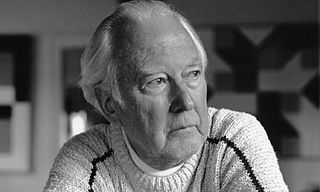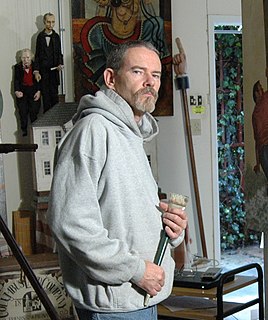Related Research Articles

Michael Heizer is an American land artist specializing in large-scale and site-specific sculptures. Working largely outside the confines of the traditional art spaces of galleries and museums, Heizer has redefined sculpture in terms of size, mass, gesture, and process. A pioneer of 20th-century land art or Earthworks movement, he is widely recognized for sculptures and environmental structures made with earth-moving equipment, which he began creating in the American West in 1967. He currently lives and works in Hiko, Nevada, and New York City.

Maurice Braun (1877–1941) was an American artist who became known for his Impressionist landscapes of southern California. He was born in Hungary on October 1, 1877; however, by the age of four, young Maurice and the Braun family had migrated to United States, and settled in New York City. His professional studies took him to the National Academy of Design, where he studied the French tradition under Francis C. Jones, George W. Maynard and Edgar M. Ward.

Meg Cranston is an American artist who works in sculpture and painting. She is also a writer.
Francis de Erdely (1904–1959) was a Hungarian-American artist who was renowned in Europe and the United States for his powerful figure paintings and drawings as well as for his teaching abilities.
Maxwell Hendler is an American painter. In 1975, he became the first contemporary artist to have pictures in the collection of the Metropolitan Museum of Art in New York.
Michael Frary was an American Modernist artist from Santa Monica, California, who was known for his interest in structural forms and architectural compositions, as well as for his Surrealist impulses. A versatile artist, Frary experimented with a range of mediums and constantly refined his approach to his subjects.

Frederick Hammersley was an American abstract painter. His participation in the 1959 Four Abstract Classicists exhibit secured his place in art history.
Tom Holland is an American visual artist. Holland is known for creating a style of art that may use fiberglass, aluminum, epoxy paint, plywood, beads, oil paint, palette knives, marble, copper, paper, and clay. For clay he uses watercolor, acrylic urethane, and ceramic glazes.
Phyllis Green is an artist whose practice involves sculpture, video and installation art. Based in Santa Monica, she has received a Guggenheim Fellowship, as well as grants from the City of Santa Monica, California Community Foundation, Durfee Foundation, Pollock-Krasner Foundation, California Arts Council, National Endowment for the Arts, Canada Council and British Columbia Cultural Fund. In 1996, she was among the first to be awarded a C.O.L.A. grant by the City of Los Angeles. In 2000, she was appointed to the Santa Monica Arts Commission, serving, as its chair from 2004 to 2006. She is married to the photographer Ave Pildas.
Michael Govan is an American art director working as the director of the Los Angeles County Museum of Art. Prior to his current position, Govan worked as the director of the Dia Art Foundation in New York City.

George Herms is an American artist best known for creating assemblages out of discarded, often rusty, dirty or broken every-day objects, and juxtaposing those objects so as to infuse them with poetry, humor and meaning. He is also known for his works on paper, including works with ink, collage, drawing, paint and poetry. The prolific Herms has also created theater pieces, about which he has said, "I treat it as a Joseph Cornell box big enough that you can walk around in. It's just a continuation of my sculpture, one year at a time." Legendary curator Walter Hopps, who met Herms in 1956, "placed Herms on a dazzling continuum of assemblage artists that includes Pablo Picasso, Kurt Schwitters, Marcel Duchamp, and Joseph Cornell, as well as California luminaries Wallace Berman and Edward Kienholz." Often called a member of the West Coast Beat movement, Herms said that Wallace Berman taught him that "any object, even a mundane cast-off, could be of great interest if contextualized properly." "That’s my whole thing," Herms says. "I turn shit into gold. I just really want to see something I've never seen before." George Herms lives and works in Los Angeles.

Ken Gonzales-Day is a Los Angeles-based conceptual artist best known for interdisciplinary projects that examine the historical construction of race, identity, and systems of representation including lynching photographs, museum display and street art. His widely exhibited "Erased Lynching" photographic series and book, Lynching in the West: 1850-1935 (2006), document the absence in historical accounts of the lynching of Latinos, Native Americans and Asians in California's early history. The series has toured in traveling exhibitions staged by the Los Angeles County Museum of Art (LACMA), Smithsonian Institution and Minnesota Museum of American Art, and appeared at the Tamayo Museum, Generali Foundation (Vienna) and Palais de Tokyo in Paris, among other venues.

The Beverly Hills Civic Center is a landmark building serving as a civic center in Beverly Hills, California.

F. Scott Hess is an American painter and conceptual artist. He has described himself as a "reluctant realist" whose work is nevertheless grounded in Old Master craft and the representation of observed detail.... Art critic Donald Kuspit suggests, "Hess uses profane realism to represent the sacred moments of life, for he knows we live in a profane world with little or no sense of the sacred, let alone of the sacredness of art".
R. Kenton Nelson is an American painter and contemporary artist from California.
Jeff Colson is an American artist.
Norman Charles Zammitt was an American artist in Southern California who was at the leading edge of the Light and Space Movement, pioneering with his transparent sculptures in the early 1960s, followed in the 1970s by his large scale luminous color paintings.

Lynn Aldrich is an American sculptor whose diverse works draw on a wide range of high and low cultural influences and materials. Her work can range from what art writers describe as "slyly Minimalist meditations" on color, light and space to whimsical "Home Depot Pop" that reveals and critiques the excesses—visual, formal and material—of unbridled consumption. Critics Leah Ollman and Claudine Ise of the Los Angeles Times have described Aldrich's art, respectively, as a "consumerist spin on the assemblage tradition" and a "witty and inventive brand of kitchen-sink Conceptualism" LA Weekly critic Doug Harvey calls her "one of the most under-recognized sculptors in L.A.," whose hallmarks are the poetic transformation of found/appropriated materials, formal inventiveness and restless eclecticism. Aldrich has exhibited at the Museum of Contemporary Art, Los Angeles (MOCA), Los Angeles County Museum of Art (LACMA), Hammer Museum, Santa Monica Museum of Art, and venues throughout the United States and Europe. She has been recognized with a Guggenheim Fellowship (2014) and public art collection acquisitions by LACMA, MOCA Los Angeles and the Portland Art Museum, among others.

Michael Maloney is a Los Angeles-based art appraiser and art dealer. He owned and operated the Michael Maloney Gallery in Santa Monica, California (1985–90) and Maloney Fine Art in Culver City, California (2006–16), and since 1998 has pursued a career as an art appraiser and private dealer in Los Angeles and New York.

Michael Light is a San Francisco-based photographer and book maker whose work focuses on landscape, the environment, and American culture's relationship to both. He is known for aerial photographs of American western landscapes collectively titled "Some Dry Space: An Inhabited West" and for two archival projects focused on historical photographs of the Apollo lunar missions and U.S. atmospheric nuclear detonation tests, represented by the books Full Moon (1999) and 100 Suns (2003), respectively. Los Angeles Times critic Leah Ollman characterized his work as "largely about what we consider ours, how we act on that assumption, and what the visual manifestations of those claims look like ... [It] seduces and troubles in shifting measure."
References
- ↑ Michael C. McMillen Archived 2014-07-02 at the Wayback Machine , L.A. Louver
- 1 2 3 4 Santa Clara University: Michael C. McMillen: Red Trailer Motel
- 1 2 3 Leah Ollman, Michael C. McMillen: Okland, at Oakland Museum of California, Art in America , November 11, 2011
- 1 2 Art review: 'Michael McMillen: Train of Thought' at the Oakland Museum of California, The Los Angeles Times , May 24, 2011
- 1 2 3 John Seed, Michael C. McMillen: Every Dream Is New, The Huffington Post , 10/03/2010
- 1 2 3 4 Metro Artworks
- ↑ Ollman, Leah (2011-07-31). "Castoffs get second life in Michael McMillen's hands". Los Angeles Times. ISSN 0458-3035 . Retrieved 2019-05-10.
- ↑ Library Foundation of Los Angeles: Michael C. McMillen Archived 2014-07-14 at the Wayback Machine
- ↑ LACMA
- ↑ Kenneth Baker, Michael C. McMillen display at Oakland Museum, San Francisco Gate , May 4, 2011
- ↑ Art Gallery of New South Wales
- ↑ Barry Whistler Gallery: Michael C. McMillen
- ↑ City of Beverly Hills: Beverly Hills Centennial Arts of Palm Installation
- ↑ "John Simon Guggenheim Foundation | Current".